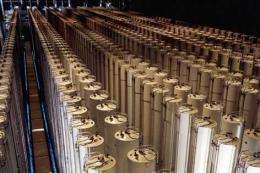Nixing new nuclear process

(PhysOrg.com) -- Risks of laser-based uranium enrichment outweigh rewards, says UCI economist Linda Cohen.
Nuclear power has made its way into the debate over alternative energy as government and commercial interests consider carbon dioxide-free sources of electricity. Advances in laser-based uranium enrichment technology promise to make the fuel powering nuclear power plants less expensive. Still, a UC Irvine economist says, the risks associated with the new method far outweigh its potential rewards.
“The process used to produce nuclear fuel for electricity is the same used to produce nuclear fuel for bombs,” says Linda Cohen, economics professor. “Making enrichment possible on a cheaper, smaller scale means the technology will be easier to steal and easier to hide.”
Cohen and Francis Slakey, a Georgetown University physicist, made this case in a recent opinion piece in the journal Nature.
Their argument centers on the perceived benefits of the new technique, which involves the separation of isotopes by lasers. It would save U.S. households no more than about $2 per month in energy costs, even taking into account the increased share of electricity that could be generated by nuclear power in the next decades.“
The cost savings from the process are an insignificant factor in whether nuclear power increases its share of either U.S. or global electricity production and is thus irrelevant to a climate-change solution,” Cohen says.
On the other hand, she notes, the new technology has serious implications for worldwide security. “Widespread nuclear proliferation is a very real threat. The risks and rewards of laser-based enrichment just don’t balance out,” Cohen says.
The opinion piece was aimed at the U.S. Nuclear Regulatory Commission, which licenses domestic nuclear power plants and enrichment facilities. The agency is reviewing an application that, if approved, would grant a license for an enrichment plant employing laser separation technology to be built in North Carolina. Currently, there are no such plants operating in the U.S. or elsewhere.
The commission has not, historically, considered the risk of nuclear proliferation when issuing licenses, Cohen says, but has the authority to do so under the Atomic Energy Act.
After publication of the Nature piece, she and Slakey were invited to meet with agency head Gregory Jaczko and with the federal Office of Science & Technology Policy. They’re hopeful about the outcome.
In a subsequent interview with NPR, Jaczko said of the proposed North Carolina plant: “It’s not similar to the kinds of enrichment facilities we’ve licensed in the past. So I certainly think there may be some things we need to take a look at and make sure we’ve got the right approach.”
Cohen believes the time to control the new technology is now, when only a few countries have the ability to build laser-driven enrichment facilities.
“This is a problem with complex social, economic, environmental and security implications,” she says, “and its solution depends on input from policymakers, practitioners and academics.”
Provided by UC Irvine















